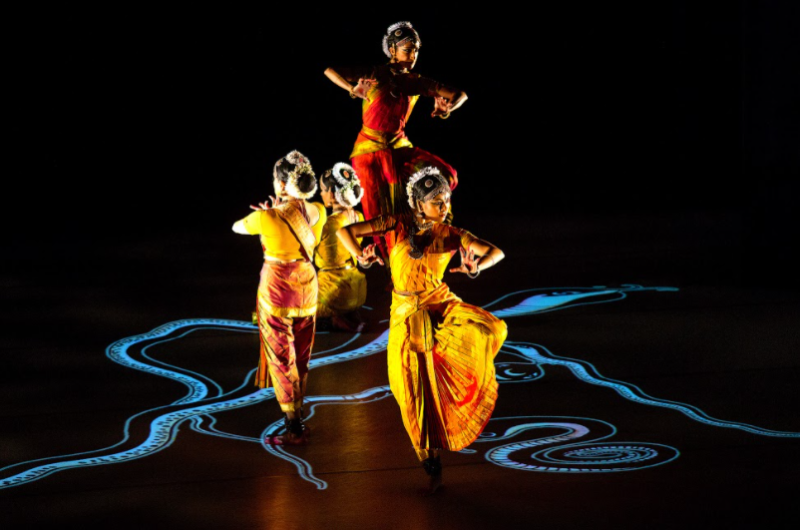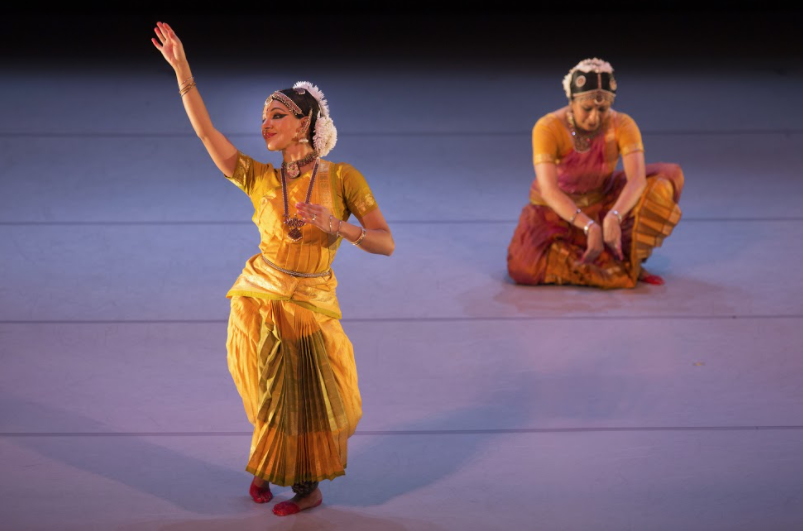Written in Water: A Dance of Snakes and Ladders
Review of Written in Water by Ragamala Dance Company at Meany Center for the Performing Arts
Written by Teen Writer Linda Yan and edited by Teen Editor Anya Shukla

Presented by the University of Washington’s Meany Center for the Performing Arts and performed by the internationally acclaimed Ragamala Dance Company, Written in Water is a stunning masterpiece for both the eyes and ears. Despite being only educated in Indian culture at the surface level, I was repeatedly touched by both the emotional and artistic qualities of the musicians and dancers.
Originally founded in 1992 in Minneapolis, the Ragamala Dance Company is today led by the mother-daughter duo Ranee and Aparna Ramaswamy, who also serve as the directors and choreographers of the company’s productions. Both first-generation Indian-American artists, the two, in their own words, are driven by their mission to create productions “influenced by their cultural hybridity” that “explore the myth and spirituality of their Indian heritage.”
As a Western viewer, I did not have a lot of context for the dance form, nor the cultural and historical events it was inspired by. Lacking this information, I likely missed many of the subtle cues and symbols hidden in this performance. However, as a self-proclaimed board game enthusiast, the first thing that caught my eye was the artwork projected on the auditorium floor, which reminded me of the classic board game snakes and ladders. As it turns out, Written in Water was inspired by the second-century Indian board game Paramapadham, also known as the original snakes and ladders. Deeply rooted in Hindu mythology, the grid of this game is representative of a person’s life. The snakes represent sins such as theft and anger while the ladders are representative of virtues including honesty and humility. The Paramapadham board projected during this performance was designed by Keshav Venkataraghavan, a cartoonist and illustrator for The Hindu newspaper.

Written in Water is performed in the style of Bharatanatyam, an ancient Indian classical dance form. It follows the epic Sufi Poem, “The Conference of the Birds,” in which the birds of the world meet to determine who their sovereign leader will be; as well as the Hindu creation story, “The Churning of the Ocean of Milk,” where the world, along with all its evil and good, is created by the churning of the Ocean of Milk. In doing so, Written in Water explores the journey each of us undergoes throughout life as we search for the answers to our personal identity, as well as our connections to the spiritual world. As the dancers travel up and down the game board, they tell stories of individual encounters with good and evil throughout their own game of life. Through delicate hand gestures and facial expressions, the dancers convey complex emotions such as sorrow, joy, and hope as they each navigate through life’s struggles and delights. For instance, melancholy sections of the dance were slow and labored as the performers used their hands to accentuate acts of crying, defeat, and hopelessness. In contrast, the joyous movements were energetic and filled with fast-paced footwork. In the unique Bharatanatyam-dance style, the torsos of the dancers remain upright throughout the performance while their body movements are concentrated in the arms and legs.
The score for this performance was written by Amir ElSaffar and is performed by the company’s own South Indian musical ensemble, which consists of vocalists, as well as musicians playing the nattuvangam, santur, mridangam, violin, and trumpet. Unfortunately, the recording did not provide translated English captioning, so I could only guess at the meaning of lyrics, but they were sung and spoken in a poignant mix of Arabic, Tamil, and other languages. While this language barrier detracted a bit from my experience, the music was truly mesmerizing and successfully accentuated the emotions and energy of the performance.
What I found especially intriguing about it was that each dancer has bells secured around their ankles which tinkled every time they moved. In other words, the music came from within the dancers. Because of this artistic choice, part of the music featured in this performance is actually improvised based on the movements and actions of the dancers.
Written in Water is a beautiful piece that weaves music, visual art, movement, and history to create a unique show that explores South Indian culture and dance. If you, like me, were completely amazed by this incredible production and just wish that you could see it live, then you are in luck! Next year the Ragamala Dance company has plans to come to Seattle live to perform their newest work, Fires of Varanasi.
Lead photo credit: Written in Water performed by Ragamala Dance Company, photographed by Bruce Palmer
The TeenTix Newsroom is a group of teen writers led by the Teen Editorial Staff. For each review, Newsroom writers work individually with a teen editor to polish their writing for publication. The Teen Editorial Staff is made up of 6 teens who curate the review portion of the TeenTix blog. More information about the Teen Editorial Staff can be found HERE.
The TeenTix Press Corps promotes critical thinking, communication, and information literacy through criticism and journalism practice for teens. For more information about the Press Corps program see HERE.


